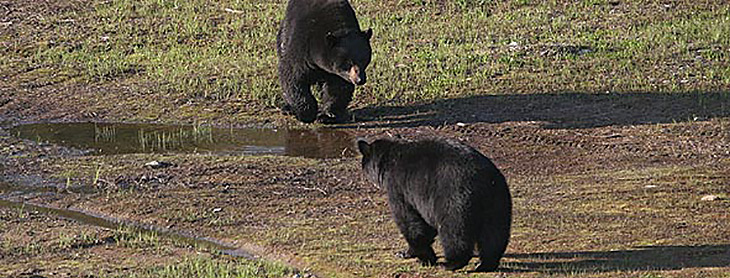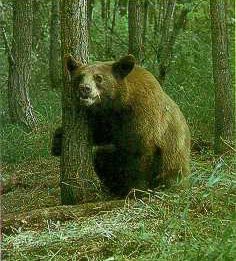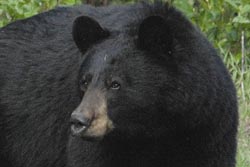
The basics of bear behaviour can be found here.
This section will empower you with the basics of interpreting and understanding black bear communication so that, when possible, your understanding can be applied to manipulate bear behaviour in the field.
The key to successfully managing human-bear conflict is being able to communicate in a way the bear can understand. This requires an understanding of bear behavior and communication.
If we observe bears interacting with each other, we can see that they communicate through their body posture, vocalizations and odour signals (Egbert & Stokes 1976; Herrero 1980). If wildlife managers use some of these forms of communication in conjunction with non-lethal tools, then they can condition or teach bears to live by our rules. These techniques require humans to think the way the bear is thinking rather than imposing our way of thinking onto the bear.
Bears communicate with each other by establishing a hierarchy or pecking order in situations where they encounter each other (Bunnell & Tait 1981; Egbert & Stokes 1976; Herrero 1985; Rogers et al. 1976). It isn’t always size that makes one bear dominant over another, it’s the attitude of the dominant bear, or “alpha,” who is always in charge. Bears communicate their dominance by intimidating their opponent. Bears do not fight with each other unless it’s absolutely necessary. Fight risks injury, and that is not the bear’s objective. It’s all about posturing.
 Bears do not understand English or French, but they do understand a language of dominance and submission. The wildlife manager can assert his dominance by posturing or faking the bear into believing the human is in control of the situation. The person then becomes the “alpha” bear, if you will, the one calling the shots. The wildlife manager’s body posture and tone of voice can make it perfectly clear to the bear that it is not welcome in an area. If the bear is not being respectful of that message, the message can be reinforced with a rubber bullet in the hindquarter or a shot of bear spray in its face delivered in an assertive manner.
Bears do not understand English or French, but they do understand a language of dominance and submission. The wildlife manager can assert his dominance by posturing or faking the bear into believing the human is in control of the situation. The person then becomes the “alpha” bear, if you will, the one calling the shots. The wildlife manager’s body posture and tone of voice can make it perfectly clear to the bear that it is not welcome in an area. If the bear is not being respectful of that message, the message can be reinforced with a rubber bullet in the hindquarter or a shot of bear spray in its face delivered in an assertive manner.
You can communicate with a bear in much the same way you might communicate with your pet dog. When my dog strolls through the neighbourhood, all the neighbours pet her and are nice to her – they welcome her to their yards. And so she continues to visit them. If, on the other hand, all my neighbours yelled at her and pelted her with rocks, she would learn to stay away and never visit them. It works the same way with bears.
Bears vary—think of a bell-shaped curve—but both habituation and food-conditioning tend to be site-specific. For bears that extend that learning beyond a site, it tends to be situation-specific. Two factors determine whether a person files a nuisance complaint—what the bear does and how the person feels about it. Many believe that nuisance behavior is a result of food-conditioning and habituation, but hunger is by far the more powerful driver. What people learn directly from the bears, no “expert” can tell them is wrong. Fear can skew interpretation of bear behaviors. Many of the behaviors that fearful people might think are ferocious are actually expressions of the bear’s own anxiety. Most bear attacks are defensive, based on fear. Bears become less likely to attack as they lose their fear of people. – Dr. Lynn Rogers
We must also consider the biological significance, if any, of human actions or signals. For instance, a loud siren has no biological significance to a bear. Sirens are not part of the language it understands – just as rub trees are rarely noticed (never mind understood) by most humans – so it usually ignores the siren. However, if the loud siren is accompanied by the assertive actions of a wildlife manager displaying an intimidating body posture and vocalizing in a loud tone that communicates dominance, then you can expect to get an appropriate and respectful reaction from the bear.
 A barking dog is also not very intimidating to most bears. For the most part, the bear has learned that barking is a harmless threat and the encounter usually ends without incident. If the dog, however, chases the bear, then the bear will usually show its submissiveness by fleeing or climbing a tree.
A barking dog is also not very intimidating to most bears. For the most part, the bear has learned that barking is a harmless threat and the encounter usually ends without incident. If the dog, however, chases the bear, then the bear will usually show its submissiveness by fleeing or climbing a tree.
Bears, like people, react to threats by evaluating their potential danger. Wildlife managers must send bears a clear message that it is unacceptable to approach people or their property. Non-lethal tactics provide an effective tool for managing bears without compromising human safety or destroying the animal.
A more detailed explanation of behaviour can be found in our manual: Responding to Human-Black Bear Conflicts – A Guide to Non-lethal Bear Management Techniques (Section 6). Download a copy here.
